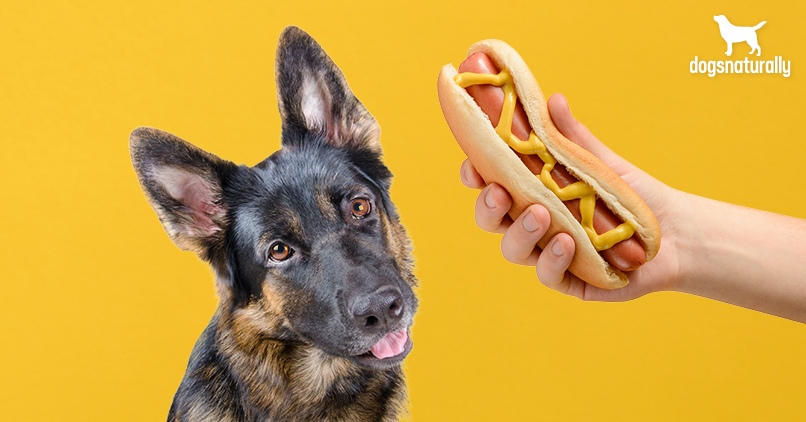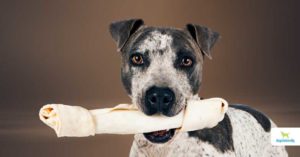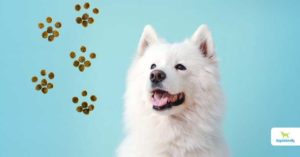Hot dogs have always been a bit of a mystery …
And while manufacturers are trying to make this barbeque staple more wholesome … many brands still contain ingredients that aren’t great for your dog. Or you for that matter.
Today I’ll cover some of the big reasons you shouldn’t share hot dogs with your dog.
After you read this you may even decide to say goodbye to hot dogs altogether …
1. Nitrates And Nitrites
Nitrate and nitrite, like sodium nitrite and potassium nitrate, are natural compounds.
The US Food and Drug Administration (FDA) approved them as a preservative … specifically for fish and meat products. They help extend the life of the products.
You’ll most often find them (usually in the form of sodium nitrite or nitrate) in cured meats like ….
- Bacon
- Jerky
- Ham
- Lunchmeat
- Smoked fish
- Hot dogs
They’re also in some commercial dog food.
But processed foods aren’t the only source of these compounds.
Nitrate actually plays an important role in plant growth. It’s a major component of chlorophyll and helps give plants the energy to grow.
For that reason, fruits and vegetables have nitrate in them. Some with higher levels of nitrate include …
- Celery
- Spinach
- Radishes
- Citrus fruit
- Cabbages
- Beets
- Carrots
While nitrates are part of a normal diet too many can cause problems, which I’ll talk about in more detail …
Toxicity And Cancer
Nitrates are much more stable than nitrites and less likely to cause harm. But when nitrates come into contact with bacteria in your dog’s saliva, they can convert to nitrites.
And nitrites can be dangerous …
When your dog eats nitrites, one of two things can happen.
- They become nitric oxide, which helps your dog. It can reduce inflammation, helps the vascular system function and can prevent cancer.
- They become nitrosamine, which harms your dog. Let’s talk about this in more detail …
When nitrites are swallowed, they can react with the acidic environment in your dog’s gut. This creates nitrous acid. If the nitrous acid reacts with amines (proteins have many) it creates nitrosamines.
Nitrosamines also occur when processed products with nitrites get heated at high temperatures.
And nitrosamines are believed to be carcinogenic. In fact, they’re one of the main carcinogens in tobacco and tobacco smoke.
Nitrosamines can cause …
- Reproductive toxicity
- Developmental toxicity
- Organ system toxicity
(Nitrites found in vegetables don’t pose as high a risk. They’re usually cooked at lower temperatures and lack high levels of protein.)
And the link between cured meats and cancer could also be because of the nitrosamines …
There are many studies that tested the effects of nitrosamines on animals. Some even looked at their effects on dogs. Exposure methods used included oral, stomach tubes and injections.
Researchers observed tumors in dogs exposed to the nitrosamines in the …
- Liver
- Lungs
- Upper respiratory system
- Nasal cavity
- Blood vessels
Nitrosamine are also believed to increase risk of gastric cancer in dogs.
Kate Allen at the World Cancer Research Fund says …
“It’s not so much nitrates/nitrites per se [that are carcinogenic], but the way they are cooked and their local environment that is an important factor … For example, nitrites in processed meats are in close proximity to proteins (specifically amino acids). When cooked at high temperatures this allows them to more easily form nitrosamines, the cancer-causing compound.”
RELATED: 5 Dog Food Trends: Should You Follow Them? …
Methemoglobin
Your dog’s red blood cells contain a protein called hemoglobin. Oxygen cells bind to the hemoglobin and get carried from his lungs to the rest of his body. Hemoglobin also carries carbon dioxide from your organs back to the lungs.
Sometimes the iron in your dog’s blood oxidizes. When this happens … hemoglobin becomes methemoglobin and oxygen can no longer bind to it.
When there’s an abnormal amount of methemoglobin your dog may develop methemoglobinemia … a blood disorder where your dog’s cells don’t get enough oxygen.
One main cause for this is when your dog eats or breathes in oxidizers …. like sodium nitrate or nitrite.
If dogs have 7.9 to 19.8 mg/kg of sodium nitrite a day, it can lead to methemoglobin production.
40 mg/kg in a day is a lethal dose in dogs.
Safe nitrate doses are much higher, as it’s much more stable.
While the nitrates and nitrites in the occasional hot dog shouldn’t be a major cause of concern … you have to ask yourself whether there’s a better treat to give your dog.
2. Monosodium Glutamate (MSG)
MSG is an excitotoxin that increases dopamine production. This tricks your dog’s brain so he thinks the food is tastier.
But it also damages the brain and makes it so your dog can’t recognize he’s full. It may even trigger learning disabilities and diseases like Parkinson’s.
It’s also linked to liver inflammation, obesity and diabetes. As well as …
- Neuroendocrine disturbances
- Behavioral issues
- Fetal brain damage
- Toxicity to the liver, thymus, brain and kidneys
MSG is present in some dog foods … and it’s also an ingredient in some brands of hot dogs.
And remember … MSG isn’t always listed as monosodium glutamate. It’s also shown as …
- Any type of protein isolate (eg soy protein isolate)
- Any type of textured protein (such as textured vegetable protein)
- Autolyzed yeast
- Hydrolyzed yeast
- Yeast extracts or yeast nutrient or yeast food
- Soy extracts
- Soy concentrate
- Sodium caseinate or calcium caseinate
- Monopotassium glutamate
- Glutamate, glutamic acid, or free glutamate
3. Artificial Sweeteners
Artificial sweeteners feed viruses and the bad bacteria and yeast in your dog’s gut.
Common sweeteners include …
- Sucrose
- Fructose
- Maldextrin
- Sorbitol
- Maltrin
There’s one more sweetener you want to keep an eye out for. This one isn’t common in hot dogs but it’s an important one to be aware of. And it’s xylitol.
Xylitol is very toxic to dogs. When your dog eats xylitol, it stimulates the rapid release of insulin. This decreases blood sugar. If your dog goes into a state of hypoglycemia (low blood sugar) … it can be life-threatening.
RELATED: What’s So Dangerous About Xylitol For Dogs? …
4. Salt
I mentioned earlier that sodium nitrate and nitrite are common in hot dogs. And these are salts.
Your dog needs salt in his diet. It helps regulate blood fluids and maintains the health of the liver, kidney and heart.
But like us, your dog only needs a small amount. Too much can lead to bloating, thirst, and a rise in blood pressure. It can also lead to …
According to the National Academy of Science, a 33 lb dog doesn’t need more than 200 mg of salt per day.
Some hot dogs can have up to 700 mg of salt. So it’s important to take a look at the packaging before you share a hot dog with your pup.
5. Choking Hazard
Not only are hot dogs full of ingredients that your dog doesn’t need in his diet … they can also be a choking hazard.
Most dogs like to scarf down their food and treats. You may have noticed your dog sometimes takes a treat and barely chews it.
Hot dogs are the perfect size to lodge in your dog’s throat. And a full hot dog can be very hard to remove from your dog’s throat, even with the Heimlich Maneuver.
If you do decide to feed your dog some hot dog, make sure to cut it into bite sized pieces.
If your dog’s choking, he may …
- Make high pitched squeaks or whistling noises
- Cough
- Gag
- Have discolored gums or tongue
- Panic
- Paw at his mouth
- Pant
- Pace
- Struggle to breath
What If Your Dog Eats A Hot Dog?
If your dog does eat a hot dog, there’s no need to panic. Make sure he isn’t choking on it and that he has lots of water available … the salt will likely make him thirsty.
One hot dog shouldn’t cause too much trouble … but it’s possible he’ll have some digestive upset if he isn’t used to it.
But if you can … it’s best to avoid hot dogs. All the additives in hot dogs mean they aren’t a good treat for dogs.
Instead, share more whole foods off the barbeque … like chicken, beef or pork without seasoning.












